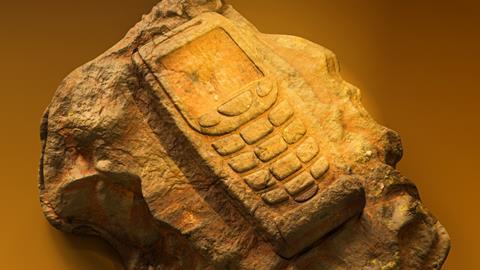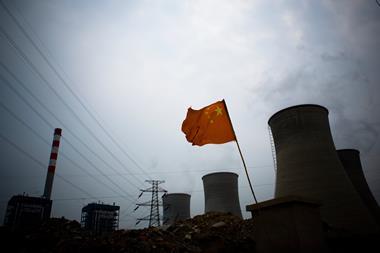The idea that we’re in a human-influenced geological epoch is gaining traction, but how will future geologists measure it? Rachel Brazil finds out
The idea for the Anthropocene came from a chemist – the Nobel prize-winning atmospheric chemist Paul Crutzen, who sadly died on 28 January this year. In 2000 he suggested that we are now in a new geological epoch, marked by the activities of humans. The idea caught the attention of the media and wider academic community because it so well encapsulated the changes that have led to our current climate crisis. But Crutzen’s statement also chimed with some geologists, who started to consider whether there really was a case for formally defining a new unit within the geological time scale. Since 2009 they have been searching for the chemical signals that would mark this new epoch.
Jan Zalasiewicz, a paleobiologist at the University of Leicester in the UK, remembers the meeting when geologists started to take the concept of an Anthropocene seriously. ‘It was, as I recall, thrown out in the “any other business” section, saying “Is it real? Does it mean anything? Should we do anything about it?”’ Geologists consider that we are currently in the Holocene epoch, which started after the last ice age and has so far lasted for 11,700 years. In 2009 Zalasiewicz became the first chair of the Anthropocene Working Group (AWG) within the International Commission on Stratigraphy (ICS) – the body that oversees global geological chronology.
The industrial revolution was just a premonition of the much bigger changes
By 2016 it was clear that there was geological evidence that could warrant the introduction of the Anthropocene, but the challenge was to characterise the exact boundary between the previous and new epoch – where and how would it be marked? The start of each geological epoch is marked by a Global Boundary Stratotype Section and Point (GSSP) – a reference point on a stratigraphic section of rock or other geological feature in a specific location. Since 1977, the ICS has maintained an international GSSP register. ‘[Once selected], we will have the representative location for the Anthropocene, we will mark its onset, and then [be able to] correlate that point across the planet,’ explains Colin Waters of the University of Leicester, UK, and current chair of the AWG.
The first debate for the AWG was when the Anthropocene should start. Crutzen initially proposed the latter part of the 18th century, to coincide with the industrial revolution. But once they started looking, ‘We realised we had something very different,’ says Zalasiewicz. ‘The industrial revolution was just like a premonition of the much bigger sharper changes.’
We started to realise a lot of the signals all align around about 1950
‘It was only when you started to talk about this topic globally and bring in colleagues from Asia and the southern hemisphere you begin to realize that that early 1800 signals weren’t of particular significance outside of Europe and North America,’ says Waters. When they examined global data ‘we started to realise a lot of the signals all align around about 1950’. In this period, often known as the ‘great acceleration’, they found an array of large, distinctive chemical signals appearing in geological records, or as Zalasiewicz calls them ‘big, chunky, solid pieces of evidence’, that coincide with a mid-20th century global industrialisation.
The golden spike

In 2018, the group received German government funding through the Berlin-based cultural exchange organisation, Haus der Kulturen de Welt, to identify a GSSP for the Anthropocene, or as it’s often known, the ‘golden spike’. They would need a dated primary marker, often chemical in nature, that clearly denotes the epoch change. ‘The most famous spike is the spike from the Cretaceous into the Tertiary [period],’ says geoscientist Simon Turner of University College London in the UK, the current secretary of the AWG. The 66 million year old boundary is marked by high iridium levels in a thin layer of sediment throughout the world in marine and terrestrial rocks which was deposited from the massive asteroid impact that also led to mass extinctions. ‘It was globally synchronous, plus or minus a few days,’ explains Turner.
The main issue is that you can only determine carbon dioxide concentrations in air bubbles preserved in glacial ice
But the golden spike isn’t always so obvious. The ideal GSSP needs to be detectable globally and synchronously, plus it should be as long lasting as possible to form a permanent record. The first step for the AWG was to select potential sites where unmixed sediments could provide a stratigraphy of the last century. The group selected 11 different sites with stratified deposits, including sediments from coastal, estuarine, lake and marine sites across the globe, from San Francisco Bay in the US, to Beppu Bay in Japan, plus coral from the Great Barrier Reef in Australia and the Cayman Islands in the Caribbean, peat samples from Poland, cave deposits from Italy and ice cores from the Antarctic. The stratified samples can be dated using radioisotope ratios, such as naturally occurring lead-210, whose half-life of 22.3 years makes it suitable for dating sediments from the last 150 years.
One obvious chemical candidate to mark the golden spike is carbon dioxide, clearly showing significant rises over the last 70 years, albeit perhaps more gradual than a spike. ‘There is still a clear inflection around 1965,’ says Waters. ‘But the main issue is that you can only determine carbon dioxide concentrations in air bubbles preserved in glacial ice and in the case of such young ice (firn ice) the air bubbles may not be fully isolated from the atmosphere.’ A more useful marker could be the ratio of carbon-12 to carbon-13, which is also preserved in the carbonates found in corals, caves and marine microfauna, as well as in carbon-rich organic sediments in peat and trees. The ratio changes because carbon from fossil fuels has less of the heavier isotope due to the preferential take-up of lighter ones in plant photosynthesis.
But the best candidate proposed so far is the artificial radioisotope fingerprint left from nuclear weapons fallout. ’From 1945 through to about 1963 there was a series of about 500 nuclear detonations in the atmosphere that greatly modified the radioisotope pattern – [before this time] plutonium was practically non-existent in the environment,’ says Waters. Because the fallout was transferred through the stratosphere, it moved around the whole planet rapidly, providing a widespread signal with a peak in the geological record prior the nuclear test ban treaty in 1963. Plus with a half-life of 24,110 years, plutonium-239 is likely to be traceable for at least 100,000 years.
Secondary markers
To make a convincing case for the Anthropocene, the group also need to define some secondary markers; ultimately they want to be able to characterise all the physical and chemical manifestations of the epoch. ‘What we want to do is demonstrate the story of the Anthropocene is one of significant global change across the board, not a marker in particular. So we are analysing a huge swathe of things,’ explains Waters. They must also consider how synchronous the chemical signals of the Anthropocene will be globally – particularly how chemicals are transferred from the more populous northern hemisphere to the less populous southern.
We don’t really see fly ash at all before industrial coal burning
One piece of evidence being studied by environmental scientist Neil Rose from University College London is carbonaceous fly ash particles produced from incomplete combustion and preserved in a range of environments. ‘They are quite morphologically distinct and are not produced by any natural processes – we don’t really see them at all before industrial coal burning,’ says Rose. As they need high temperatures to form, they are a distinct indicator of emissions from coal and oil power stations.
The process for analysing these particles involves digesting sediments with nitric, hydrofluoric and hydrochloric acids to remove organic, siliceous and carbonate fractions, leaving the chemically robust porous carbon particles around 50µm in size. These are then simply counted under a microscope to calculate their concentration in a given sample. In 2015 Rose published a study from 70 global lake sediments showing how their concentrations varied with time.1 ‘The start of [the fly ash particle] record begins in the middle of the 19th century,’ explains Rose. ‘We are finding more globally [that there] is a big increase in these particles at about 1950.’

Another feature of the Anthropocene are microplastics – the broken down remains of our plastic bags and cups have turned out to be more than local litter, creating a global record in soils, rivers and deep ocean sediments. So far limited data has been collected but oceanographer and microplastics expert Juliana do Sul, based at the Leibniz Institute of Baltic Sea Research in Rostock, Germany, is hoping to add to our current understanding and map the stratigraphy of microplastic deposition as a potential secondary Anthropocene marker.
Microplastic particles in sediments are identified using FTIR or Raman spectroscopy, but the particles must first be separated, initially by density and then through chemical or enzymatic removal of other organic material, to leave the 10–100µm microplastic particles. Do Sul is currently analysing samples from Baltic Sea anoxic basin ‘dead zone’ deposits. ‘As the name suggests, [there is] no oxygen, which means there are no animals living in the sediments, and so it is free from bioturbation – the movements of invertebrates in the sediment column. So you can have a high degree of certainty on when the sediment was deposited,’ says Do Sul.
In such settings it’s likely plastics will remain preserved over geological timescales, but there are unanswered questions over the degree of chemical degradation that could take place. ’They may be around for some thousands of years, but we don’t really know what they do beyond that; they may break down into some sort of polymer, or some sort of chemical signature, which may [still] be detectable beyond that,’ suggests Rose.
One idea is that the microplastics could themselves provide a stratigraphy based on polymer type, as we know throughout the 20th century there have been changes in the types and relative quantities of different polymers produced. In the same way that geologists use the changing fossil record to identify much earlier epochs, Do Sul envisions that we might be able to observe changes in the abundance of specific polymers; for example, earlier plastics such as polyvinyl chloride (introduced in the 1950s) compared to polyethylene terephthalate (introduced in the 1970s).2 Of course, whether this level of differentiation will be detectable remains to be seen, but Do Sul says it’s an avenue they are exploring.
Chemical footprints

It turns out there is no shortage of other chemical footprints that could define the Anthropocene in the geological record. ‘[One] that’s particularly important is the change to the nitrogen cycle,’ says Waters. Agriculture has had a massive impact since the Haber–Bosch process in 1913, with 175 million tons of ammonia now produced each year, much of it for fertilisers, leaving elevated levels of nitrogen since the 1950s that can be detected in sediments and ice cores. Human activity has now completely transformed one of the global cycles of life. ‘[It’s probably] the greatest change to the nitrogen cycle since the early protozoic, about 2.5 billion years ago,’ says Zalasiewicz.
The Haber–Bosch process is the greatest change to the nitrogen cycle in about 2.5 billion years ago
Humans are also responsible for metals not seen in nature, whose traces can be detected in sediments and ice cores. ‘The one we use is the aluminium signal,’ says Waters, ‘We’ve [now] got 400 million tonnes on the planet; 98% of that has been produced since 1950.’ Traces of organic compounds could also mark the Anthropocene - for example, cores from the Clyde estuary in Scotland analysed in 2011 showed massive increases in polychlorinated biphenyls, a once widely used electrical insulator and coolant, from less than 4.3mg to 4386mg per kilogram of sediment, peaking from 1965–1977.3
’A massive indicator of the Anthropocene would be just the numbers of new chemicals which have been generated in the world,’ says Rose. Turner agrees that the diversity of materials created by chemists from the mid-20th century onwards clearly marks a change. ‘If you’re recycling urban waste in the 1930s, you probably could have done it relatively simply between wood, plastic, metal, and glass, but to go through municipal waste now, there is a diversity of chemicals in all sorts of materials: it’s not just glass, it’s different types of glasses; it’s not just plastic, it’s an absolute rainbow of plastics.’ But whether all these chemical signals will last long enough to be considered for long-term geological markers is an open question. ‘It’s really something we need to talk [about] with more chemists,’ says Zalasiewicz.
The AWG hopes to conclude its work to select a golden spike by 2022,4 but there is no certainty its decision will be formally accepted by the International Commission on Stratigraphy itself. ‘The idea [that] we [are in] an epoch seven decades long, marked by things like plastic – it’s far removed from [conventional] geology … so whether it will be accepted or not, I think is still an open question,’ says Zalasiewicz. ‘I think the community is quite divided,’ adds Rose.
Anthropocene politics
Philip Gibbard, a geologist at the University of Cambridge in the UK and current secretary-general of the International Commission on Stratigraphy is one of those with some reservations, in what he describes as a friendly debate between colleagues. He argues that our current epoch, the 11,700 year old Holocene, was itself defined by the presence of Homo sapiens. ‘The Holocene is characterised by a substantial increase in human numbers, which has been going on, of course, right to the present day … we’re effectively modifying our environment all the time, through our own activities, clearing vegetation, mining [and] building,’ he says.
Gibbard adds that having a boundary in the 1950s would mean he was born in the Holocene and not the new Anthropocene. ‘This is a trivial point, but it means that I’ve lived through that boundary, and I didn’t even notice it and that bothers me!’
”Late Holocene” doesn’t have the same kind of impact or meaning as the Anthropocene
One compromise might be to create a new sub-division of the Holocene, rather than a new epoch. The most recent new sub-division, the 4200-year-old Meghalayan Age, was agreed in 2018 and named after the Mawmluh Cave in the Indian state of Meghalaya. Its golden spike marks a shift in oxygen isotope ratios, which denotes a break in the formation of calcium carbonate stalagmites on the cave floor. The signal is thought to represent a time of centuries-long global drought. Gibbard suggests a similar sub-division to mark the last 70 years might be more legitimate.
What concerns Gibbard and others is that the definition of the Anthropocene is becoming more political than geochemical. ‘A lot of people have jumped on this term: the popular media, but also our colleagues in the social sciences and the arts. And what has been very interesting for us to watch is the way that people in those subjects don’t seem to need to define terminology,’ he says. The geological function of defining this epoch may be becoming secondary to getting across the idea that humans have become a dominant and possibly destructive force, particularly in the context of the climate crisis. For Zalasiewicz, there is certainly a wider power in defining a new epoch. ‘”Late Holocene” doesn’t have the same kind of impact or meaning … the message is quite different.’
It may be that, whatever the geologists formally decide, the genie is already out of the bottle. ‘We’re not policemen – we can’t stop other people from using this term,’ says Gibbard. The Anthropocene concept has already unleashed a wealth of scientific literature, artistic engagement and public debate. ‘I think the utility of it will endure … formalised or not, it is not going to go away,’ says Turner. But having no formal definition may be the worst of both worlds, suggests Waters, ‘I think we want some degree of consistency. So everyone knows, with a new term, what’s meant by it.’
In the geological timescale, the Anthropocene and its chemical legacy is likely to end up being a tiny blip. But if anyone is around in millions of years to examine the future geological record, they may still find the ‘techno-fossils’ of the Anthropocene. Perhaps, says Rose, ‘whereas we [now] see, for example, an imprint of an ammonite in a rock record, we may [then] see an imprint of a Coke can, CD or Lego brick.’
Rachel Brazil is a science writer based in London, UK
Updated 01 February 2021 to correct the name and affiliation of Colin Waters
References
1 N L Rose, Environ. Sci. Technol., 2015, 49, 4155 (DOI: 10.1021/acs.est.5b00543)
2 C E P Bancone et al, Front. Environ. Sci., 2020, 8, 154 (DOI: 10.3389/fenvs.2020.574008)
3 C H Vane et al, Phil. Trans. R. Soc. A., 2011, 369, 1085 (DOI: 10.1098/rsta.2010.0298)
4 C N Waters et al, Earth Sci. Rev., 2018, 178, 379 (DOI: 10.1016/j.earscirev.2017.12.016)













No comments yet